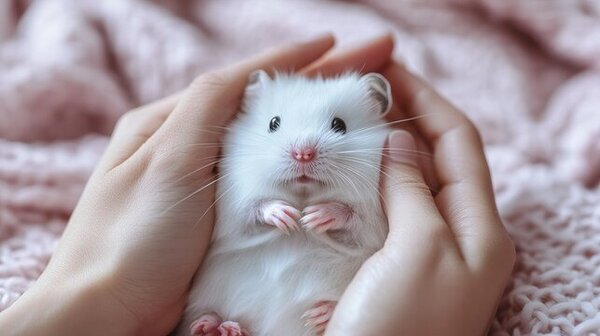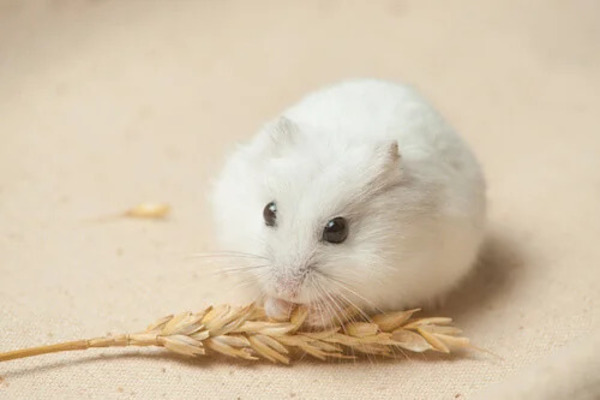White dwarf hamsters, a type of dwarf hamster known for their soft, white fur and small size, are among the most popular pets for families, especially in smaller living spaces. These hamsters are easy to care for, gentle, and active, making them ideal companions for beginners and experienced pet owners alike. This guide will cover essential information about white dwarf hamsters, from their characteristics to their care requirements, helping you decide if they’re the right pet for you.

White dwarf hamsters are often a variation of the Winter White Dwarf Hamster (Phodopus sungorus), a species native to parts of Russia and Central Asia. They are known for their ability to change their fur color with the seasons, especially in the wild, where they can develop a white coat in winter to blend in with snowy environments. In captivity, some retain this seasonal coloring, while others remain white all year round.
White dwarf hamsters are small, typically around 3-4 inches long and weighing 1-2 ounces. Their small, round bodies are covered with soft, white fur, and they have large, dark eyes that give them an adorable appearance. They have short tails, tiny paws, and little round ears, adding to their cuteness.
| Characteristic | Description |
|---|---|
| Size | 3-4 inches (7.5-10 cm) |
| Weight | 1-2 ounces (28-56 grams) |
| Lifespan | 1.5-3 years |
| Color | White fur (can change seasonally) |
| Temperament | Friendly, social, curious |
White dwarf hamsters are known for their friendly and gentle nature. They are social animals and enjoy interacting with their human caregivers. They are generally less likely to bite than some other hamster species, which makes them ideal for children. However, it’s essential to handle them gently and provide plenty of interaction time to keep them happy and tame.
Creating a comfortable and stimulating environment is essential for a white dwarf hamster’s well-being. Here are some tips:
Cage Size: Choose a spacious cage with good ventilation. A minimum of 24x12 inches is ideal, though larger is always better.
Bedding: Use soft, absorbent bedding like paper or aspen shavings. Avoid cedar and pine, as they can cause respiratory problems.
Hiding Spots: Provide a hideaway or nest box for security and comfort.
Exercise Wheel: Include an exercise wheel (preferably solid-surfaced) for daily activity.
Enrichment: Add tunnels, chew toys, and climbing structures to keep your hamster mentally stimulated.
A balanced diet is essential for your white dwarf hamster’s health:
Pellets: Use high-quality hamster pellets as a primary food source.
Fresh Vegetables: Provide small amounts of safe vegetables like carrots, spinach, or broccoli.
Occasional Treats: Hamsters enjoy the occasional piece of fruit, but avoid sugary fruits as white dwarf hamsters can be prone to diabetes.
Water: Ensure fresh water is always available in a bottle or shallow dish.
White dwarf hamsters generally live for 1.5 to 3 years. Regular check-ups with a veterinarian who specializes in small animals can help prevent health issues. Common issues include:
Obesity: Due to lack of exercise or overfeeding.
Dental Problems: Hamsters’ teeth grow continuously, so provide chew toys.
Diabetes: White dwarf hamsters are susceptible to diabetes, so monitor sugar intake.
White dwarf hamsters are social but need to be handled carefully. Here’s how to make handling smooth:
Introduce Gradually: Start by gently speaking to them and offering treats to gain trust.
Avoid Daytime Handling: Since hamsters are nocturnal, they’re more active and receptive to handling in the evening.
Handle Carefully: Use two hands to scoop them up, avoiding sudden movements that might frighten them.
Are white dwarf hamsters good for children?Yes, they are gentle and usually tolerant of gentle handling, making them suitable for kids who can be calm and respectful with animals.
Do white dwarf hamsters need companions?Most dwarf hamsters are social, but white dwarf hamsters can live happily alone or in pairs if introduced early and carefully.
How often should I clean their cage?Clean the cage weekly to prevent odors and maintain health, but spot-clean daily if needed.
White dwarf hamsters make fantastic pets for those looking for a small, friendly companion. Their easy-going temperament, combined with their manageable size, makes them an excellent choice for households of all types. With proper care, a well-balanced diet, and a safe, stimulating environment, a white dwarf hamster can thrive and bring joy to your home for years. Whether you’re a first-time pet owner or an experienced animal lover, these charming little pets are sure to brighten your day.

Yes, white hamsters, especially Winter White Dwarf Hamsters, are generally friendly and easy to handle. They have a calm and gentle temperament compared to other hamster species, which makes them a popular choice as pets, even for children. While they may be shy or skittish at first, with regular and gentle handling, white hamsters can become quite tame and develop a trusting bond with their caregivers. It's important to handle them carefully and respect their small size to prevent stress or injury.
Yes, Winter White Dwarf Hamsters can live alone and are actually often better suited to solitary living. While some dwarf hamsters can coexist peacefully when raised together from a young age, adult hamsters tend to become territorial and may show aggression if housed with another hamster, even of the same species. For this reason, it's generally recommended to house Winter White Dwarf Hamsters individually unless they have been together since birth. This can help prevent injuries and reduce stress, leading to a happier and healthier pet.
Caring for a Winter White Dwarf Hamster involves providing a safe, comfortable habitat, a balanced diet, and regular enrichment. Here’s a guide to essential care for these small pets:
Habitat: A large, well-ventilated cage is ideal, with a minimum size of 24x12 inches. Include solid-bottom floors and use hamster-safe bedding like paper-based or aspen shavings. Avoid cedar or pine bedding as it can irritate their respiratory system.
Diet: A balanced diet of hamster pellets provides essential nutrients. You can supplement with occasional treats like fresh vegetables (e.g., carrots, cucumbers) and small pieces of fruit, but avoid sugary foods as dwarf hamsters can be prone to diabetes.
Water: Ensure a constant supply of fresh water. A water bottle with a sipper tube works best to keep the cage clean and water easily accessible.
Exercise: Winter White Dwarf Hamsters are active and need plenty of exercise. Provide a solid-surface exercise wheel, tunnels, and toys for mental and physical stimulation. Rotate toys regularly to prevent boredom.
Enrichment and Socialization: Hamsters enjoy exploring, digging, and chewing. Add various toys, chew sticks, and tunnels to engage their natural instincts. Regular gentle handling can help them stay tame and feel bonded with their owner.
Cleaning: Clean the cage weekly to reduce odor and prevent disease. Spot clean daily to remove waste, but avoid over-cleaning as it may stress the hamster.
The cost of a Winter White Dwarf Hamster varies depending on location, source, and demand, but typically ranges from $10 to $20 USD at most pet stores. Specialty or ethically bred hamsters may cost slightly more, reflecting higher quality care and genetic diversity. Additional supplies such as a cage, bedding, food, and toys usually bring initial setup costs to around $50 to $100 USD, with ongoing monthly expenses for food and bedding.
Winter White Dwarf Hamsters, like some other hamster species, have been used in medical research, although they are less common in research compared to Syrian hamsters. In scientific studies, they offer insights into fields like:
Diabetes Research: Winter White Dwarf Hamsters are prone to developing diabetes, making them a model for studying the disease, understanding genetic predispositions, and testing potential treatments.
Metabolic and Obesity Studies: Due to their tendency to gain weight easily, white dwarf hamsters serve as useful models for studying metabolic processes, obesity, and related health conditions.
Genetic Studies: Winter White Dwarf Hamsters can offer insights into genetic variability, particularly in studying fur coloration and seasonal changes, which can be applied to understanding genetic expression and adaptation in other species.
While not as commonly used as other lab animals, the research on Winter White Dwarf Hamsters contributes to broader scientific understanding and may help develop therapies for metabolic disorders and genetic conditions.
animal tags: White-Dwarf-Hamster
We created this article in conjunction with AI technology, then made sure it was fact-checked and edited by a Animals Top editor.